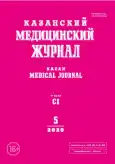Прогностическое значение параметров дыхания у пациентов с синдромом обструктивного апноэ во сне и хронической сердечной недостаточностью с сохранённой фракцией выброса
- Авторы: Яковлев А.В.1, Маянская С.Д.2, Шилов С.Н.1, Тепляков А.Т.3, Ширинский И.В.4, Яковлева Н.Ф.1
-
Учреждения:
- Новосибирский государственный медицинский университет
- Казанский государственный медицинский университет
- Научно-исследовательский институт кардиологии Томского национального исследовательского медицинского центра Российской академии наук
- Научно-исследовательский институт фундаментальной и клинической иммунологии
- Выпуск: Том 101, № 5 (2020)
- Страницы: 652-660
- Тип: Теоретическая и клиническая медицина
- URL: https://journals.rcsi.science/kazanmedj/article/view/41901
- DOI: https://doi.org/10.17816/KMJ2020-652
- ID: 41901
Цитировать
Аннотация
Цель. Изучить отдельные функциональные параметры дыхания в различные фазы сна у пациентов с синдромом обструктивного апноэ во сне и хронической сердечной недостаточностью с сохранённой фракцией выброса и оценить их влияние на клиническое течение заболевания.
Методы. В исследование были включены 86 мужчин с синдромом обструктивного апноэ во сне. Всем пациентам при включении в исследование были выполнены полисомнография, эхокардиография, определение уровня мозгового натрийуретического пептида, тест 6-минутной ходьбы. Через 12 мес проспективного наблюдения ретроспективно, в зависимости от характера течения хронической сердечной недостаточности пациенты были разделены на две группы: с неблагоприятным (n=33) и благоприятным (n=53) клиническим течением. При проведении статистического анализа для оценки прогностической значимости исследованных параметров дыхания в отношении течения заболевания использовали методы логистической и линейной регрессии.
Результаты. Установлена достоверная роль следующих параметров дыхания в качестве предикторов прогрессирования хронической сердечной недостаточности: индекса обструктивного апноэ/гипопноэ за весь ночной сон [отношение шансов (ОШ) в 1,04, p=0,002] и в фазу сна с быстрым движением глаз (REM-фазу) (ОШ 1,24, p=0,001); индекса дыхательных расстройств за весь период сна (ОШ 1,06, p=0,044) и в REM-фазе сна (ОШ 1,25, p=0,003). Для повторных госпитализаций была определена прогностическая роль индекса обструктивного апноэ/гипопноэ в REM-фазе сна (ОШ 1,07, p=0,044) и индекса дыхательных расстройств в REM-фазе сна (ОШ 1,13, p=0,040).
Вывод. Выявлено прогностическое значение для пациентов с синдромом обструктивного апноэ во сне и хронической сердечной недостаточностью с сохранной фракцией выброса индекса обструктивного апноэ/гипопноэ и индекса дыхательных расстройств за весь период сна и избирательно в REM-фазе, что позволяет рассматривать данные параметры в качестве независимых предикторов неблагоприятного клинического течения в этой группе больных.
Полный текст
Открыть статью на сайте журналаОб авторах
Алексей Владимирович Яковлев
Новосибирский государственный медицинский университет
Автор, ответственный за переписку.
Email: alex-yak-card@mail.ru
Россия, г. Новосибирск, Россия
Светлана Дмитриевна Маянская
Казанский государственный медицинский университет
Email: alex-yak-card@mail.ru
Россия, г. Казань, Россия
Сергей Николаевич Шилов
Новосибирский государственный медицинский университет
Email: alex-yak-card@mail.ru
Россия, г. Новосибирск, Россия
Александр Трофимович Тепляков
Научно-исследовательский институт кардиологии Томского национального исследовательского медицинского центра Российской академии наук
Email: alex-yak-card@mail.ru
Россия, г. Томск, Россия
Иван Валерьевич Ширинский
Научно-исследовательский институт фундаментальной и клинической иммунологии
Email: alex-yak-card@mail.ru
Россия, г. Новосибирск, Россия
Наталья Фаритовна Яковлева
Новосибирский государственный медицинский университет
Email: alex-yak-card@mail.ru
Россия, г. Новосибирск, Россия
Список литературы
- Butt M., Dwivedi G., Khair O., Lip G.Y.H. Obstructive sleep apnea and cardiovascular disease. Int. J. Cardiol. 2010; 139: 7–16. doi: 10.1016/j.ij.card.2009.05.021.
- Mentz R.J., Fiuzat M. Sleep-disordered breathing in patients with heart failure. Heart Failure Clin. 2014; 10: 243–250. doi: 10.1016/j.hfc.2013.10.001.
- Lindberg E. Epidemiology of OSA. Eur. Respir. Mon. 2010 (50): 51–68. doi: 10.1183/1025448x.00025909.
- Peppard P.E., Yooung T., Barnet J.H. et al. Increased prevalence of sleep-disordered breathing in adults. Am. J. Epidemiol. 2013; (177): 1006–1014. doi: 10.1093/aje/kws342.
- Fletcher E.C. Effect of episodic hypoxia on sympathetic activity and blood pressure Respir. Physiol. 2000; 119 (2–3): 189–197. doi: 10.1016/s0034-5687(99)00114-0.
- Frantz R.P., Farber H.W., Badech D.B. et al. Benzal Baseline and serial brain natriuretic peptide level predicts 5-year overall survival in patients with pulmonary arterial hypertension. CHEST. 2018; 154: 126–135. doi: 10.1016/j.chest.2018.01.009.
- Kasai T., Bradley T.D. Obstructive sleep apnea and heart failure: pathophysiologic and therapeutic implications. J. Am. Coll. Cardiol. 2011; 57 (2): 119–127. doi: 10.1016/j.jacc.2010.08.627.
- Van Deursen V.M., Urso R., Laroche C. et al. Comorbidities in patients with heart failure: an analysis of the European Heart Failure Pilot Survey. Eur. J. Heart Fail. 2014; 16: 103–111. doi: 10.1016/s0735-1097(13)60738-x.
- Bitter T., Westerheide N., Prinz C. et al. Cheyne–Stokes respiration and obstructive sleep apnoea are independent risk factors for malignant ventricular arrhythmias requiring appropriate cardioverter-defibrillator therapies in patients with congestive heart failure. Eur. Heart J. 2011; 32: 61–74. doi: 10.1093/eurheartj/ehq327.
- Patrick J., Hanly S., Naneed S., Zuberi Khokhar. Increased mortality associated with Cheine–Stokes respiration in patients with congestive heart failure. Am. J. Respir. Crit. Care Med. 1996; 153 (1): 272–276. doi: 10.1164/ajrccm.153.1.8542128.
- Sekizuka H., Osada N., Miyake F. Sleep disordered breathing in heart failure patients with reduced versus preserved ejection fraction. Heart Lung Circ. 2013; 22: 104–109. doi: 10.1016/j.hlc.2012.08.006.
- Chami H.A., Baldwin C.M., Silverman A. et al. Sleepiness, quality of life, and sleep maintenance in REM versus non-REM sleep-disordered breathing. Am. J. Respir. Crit. Care Med. 2010; 181: 997–1002. doi: 10.1164/rccm.200908-1304oc.
- Mokhlesi B., Finn L.A., Hagen E.W. Obstructive sleep apnoea during REM sleep and hypertension: results of the Wisconsin Sleep Cohort. Am. J. Respir. Crit. Care Med. 2014; 190: 1158–1167. doi: 10.1164/rccm.201406-1136oc.
- Weitzenblum E., Krieger J., Apprill M. et al. Daytime pulmonary hypertension in patients with obstructive sleep apnea syndrome. Am. Rev. Respir. Dis. 1988; 138: 345–349. doi: 10.1164/ajrccm/138.2.345.
- Gami A.S., Olson E.J., Shen W.K. et al. Obstructive sleep apnea and the risk of sudden cardiac death: a longitudinal study of 10,701 adults. J. Am. Coll. Cardiol. 2013; 62 (7): 610–616. doi: 10.1016/j.jacc./2013.04.080.
Дополнительные файлы






